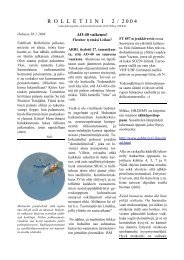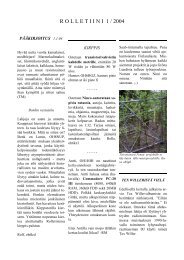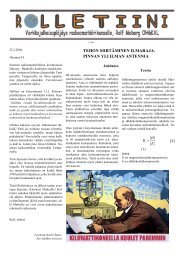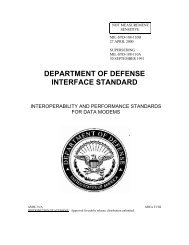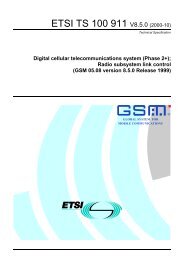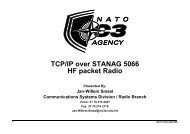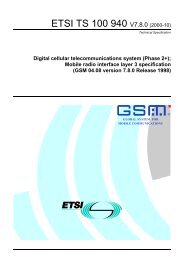nato unclassified - Ham-pages ... No indexes at this level
nato unclassified - Ham-pages ... No indexes at this level
nato unclassified - Ham-pages ... No indexes at this level
Create successful ePaper yourself
Turn your PDF publications into a flip-book with our unique Google optimized e-Paper software.
NATO UNCLASSIFIED<br />
STANAG 5066: PROFILE FOR MARITIME HF DATA COMMUNICATION<br />
V1.0.2<br />
Description:<br />
This primitive can be sent asynchronously to all or selected clients connected to the<br />
Subnetwork Interface Sublayer to inform them of changes in the st<strong>at</strong>us of the node to<br />
which they are <strong>at</strong>tached. For example, <strong>this</strong> primitive can be used to inform clients<br />
th<strong>at</strong> all available resources (i.e. bandwidth) have been temporarily reserved by a high<br />
ranked client or th<strong>at</strong> the node has entered an EMCON st<strong>at</strong>e and as a result they<br />
should only expect to receive D<strong>at</strong>a but will not be allowed to transmit d<strong>at</strong>a. The <strong>No</strong>de<br />
St<strong>at</strong>us argument specifies the new St<strong>at</strong>us of the node. Possible values of <strong>this</strong><br />
argument are: ON, OFF, Receive-Only, Transmit-Only-to-Specific-Destin<strong>at</strong>ion-<br />
<strong>No</strong>de/SAP, etc. If the Subnetwork St<strong>at</strong>us is other than ON, the Reason argument<br />
explains why. Possible values of <strong>this</strong> argument are: Local-<strong>No</strong>de-In- EMCON, Hard-<br />
Link-Requested-By High-Priority-client, etc. The contents of <strong>this</strong> primitive are not<br />
yet defined.<br />
A.2.1<br />
Encoding of Primitives<br />
Figure A-1 (a-h) below shows the encoding of the S_Primitives. . The bits shall be mapped<br />
into fields in accordance with CCITT V.42, 8.1.2.3, which st<strong>at</strong>es th<strong>at</strong>:<br />
• when a field is contained within a single octet, the lowest bit number of the field<br />
represents the lowest-order value<br />
• when a field spans more than one octet, the order of bit values within each octet<br />
progressively decreases as the octet number increases. The lowest bit number<br />
associ<strong>at</strong>ed with the field represents the lowest-order value.<br />
The 4 byte address field in the S_primitives shall carry the 3.5 byte address defined in<br />
C.3.1.4. The lowest order bit of the address shall be placed in the lowest order bit position of<br />
the field (generally bit 0 of the highest byte number of the field), consistent with the mapping<br />
in D_PDUs.<br />
As shown in Figure A-1(a), Aall primitives shall begin with the 16-bit Maury-Styles<br />
sequence shown below, with the least significant bit (LSB) transmitted first:<br />
(MSB) 1 1 1 0 1 0 1 1 1 0 0 1 0 0 0 0 (LSB)<br />
Following the Maury-Styles sequence, the next 8 bits shall carry the 5066 version number.<br />
For <strong>this</strong> version of 5066, the version number shall be all zeros.<br />
The next 16 bits shall carry the size in bytes of the S_primitive to follow, exclusive of the<br />
Maury-Styles sequence, version field, and <strong>this</strong> size field. The LSB of the of the size value<br />
shall be mapped into the low order bit of the field.<br />
Unless specified otherwise, the order of bit transmission shall be as described in CCITT V.42<br />
paragraph 8.1.2.2, which specifies th<strong>at</strong> the least significant bit (LSB, bit 0 in the figures<br />
below) of byte 0 shall be transmitted first. The remaining bytes shall be transmitted<br />
sequentially, also beginning with the LSB of each byte.<br />
NATO UNCLASSIFIED<br />
16




